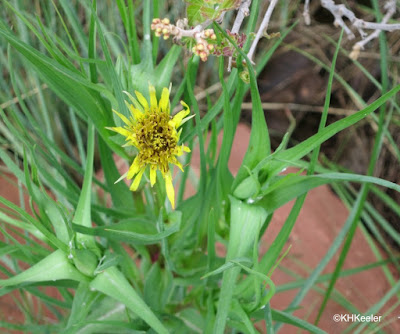Go out and notice the flowers!
Like any natural area--and parks and gardens and agricultural fields as well--what you see depends on when you go. I hiked there on a late May morning, preparing to lead a plant walk.
Here are a few of the plants I saw:
The entrance to the trails crosses a low spot occupied by trees and shrubs including this cottonwood (Populus deltoides, willow family, Salicaceae) getting ready to release its seeds. Cottonwoods are dioecious, some plants making only pollen and others only seeds, so this tree is "female" (pistilate, technically).
The sides of the path beyond the cottonwood are dominated by weedy plants because they tolerate being walked on and broken --that's part of what makes them "weedy". Pictured below is a common European weed of Larimer County, yellow salsify, Tragopogon dubius (sunflower family, Asteraceae). It is one of three species of Tragopogon in this area, all of them introduced (see my blog on them). I have long thought that "dubius," meaning dubious, questionable, was an amusing word to choose for a plant name.
Stepping through areas where native plants far outnumber the introduced ones, there were many native wild onions (Allium there are several species, amaryllis family, Amaryllidaceae) in flower.
American wild onions are edible, they smell and taste "like onions." The problem is this next plant, deathcamas (Toxicoscordion venenosum was Zigadanthus venenosus, deathcamas family Melanthiaceae). As its name implies, it is very poisonous. With flowers present, you can probably always tell it from wild onions, but without flowers, the way to tell the leaves apart is that deathcamas doesn't smell like onions. By the time your hands reek of onions from gathering them, that's a poor character to rely on to avoid being poisoned. Deathcamas was growing in the same places as the wild onions. So only experts safely gather wild onions.
Both onions and deathcamas were at one time classified as being in the lily family, Liliaceae. Modern analysis, looking at more specimens and using DNA data, has resulted in separating lily-like plants into numerous smaller families, rather than keeping them in one huge very diverse lily family. Both onions and deathcamas are certainly lily-like monocotyledons, with grass-like leaves and flower parts in 3's or 6's.
I like violets generally, and the one below is a really nice one, yellow prairie violet or Nuttall's violet, Viola nuttallii (violet family, Violaceae). My photo doesn't show it well, but the leaves are long and narrow, slightly wider in the middle (lanceolate). Most violets have heart shaped leaves. The yellow prairie violet is a native violet found in mid-continent from Canada to New Mexico.
It has been a very rainy May. The grasslands of the Rocky Mountain foothills are tall and green. This post shows only a few of the flowers I saw. It is a good year for flowering by the late spring plants and should as well be a really good year for plants that are just getting ready to flower, the flowers of early summer.
Don't miss the wildflowers, wherever you are!
Questions and comments welcome.
Text revised 2 days after posting because I couldn't stand the typos I saw.
For wildflower identification at Devil's Backbone,
See the beautiful photographs at Eastern Colorado Wildflowers http://www.easterncoloradowildflowers.com/index.htm
Compare to the photos in Young, H. 2014. Wildflowers and other plants of the Larimer County foothills region. Larimer County Natural Resources, Loveland, CO. Print.
Work the plant keys in
Weber, W. A. and R. C. Wittmann. 1996. Colorado flora, eastern slope, 3rd edition. University Press of Colorado, Boulder.
Kathy Keeler
More at awanderingbotanist.com









No comments:
Post a Comment